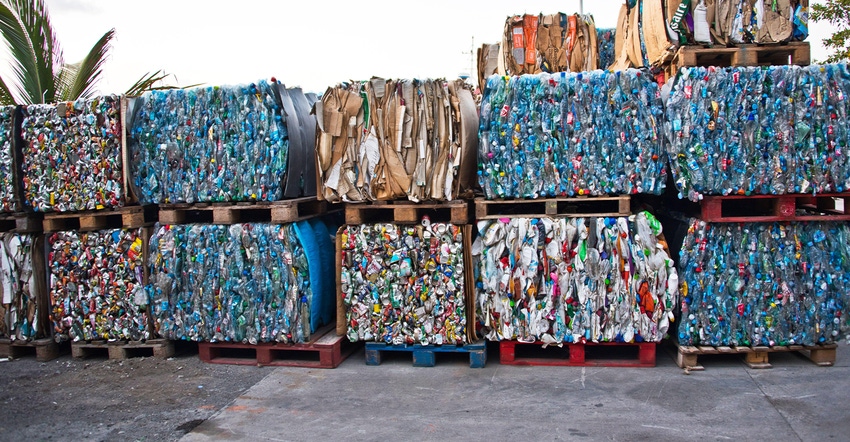I asked myself this question as I was preparing to speak at my home county’s Recycling Awards ceremony. I wanted to let our award winners know their efforts are not in vain. While they may have seen or read stories claiming recycling is a hoax, I knew our county’s recyclables are being turned into new products.

I asked myself this question as I was preparing to speak at my home county’s Recycling Awards ceremony. I wanted to let our award winners know their efforts are not in vain. While they may have seen or read stories claiming recycling is a hoax, I knew our county’s recyclables are being turned into new products.
I decided to start off with a series of before and after pictures. Before was pictures of the different materials we put in our curbside bins: aluminum and steel cans, corrugated boxes, PET bottles, etc. After was the products they are recycled into.
Some new products are easy to show. Our aluminum cans are turned back into cans. Our steel cans are made back into cans or other steel products. Our boxes are turned into linerboard and corrugated medium and then used to make new boxes. Our mixed paper is used to make recycled paperboard for cereal boxes and other products.
Food and yard waste are easy, too. Our yard waste is composted in-county and turned into a soil conditioner. Our food waste goes to a composting facility in a neighboring county where it is also turned into a soil conditioner.
Glass is more challenging. Curbside glass is not color sorted. Nonetheless, we are somewhat unique in that ours goes to a glass recycling company that has the equipment to optically sort some of the broken glass for resale to glass bottle companies. The rest goes to different aggregate uses.
Plastics are the hardest to explain because the different resins and products in our bins results in a slew of different markets. Two are easy enough. PET containers can go into fiber uses such as new carpets or into new bottles. Ours go to whomever pays the most. Natural HDPE milk and water jugs are prized by consumer products companies because they are not dyed. Their recycled pellets can be dyed and used for detergent, shampoo, and other packages. Natural’s versatility currently makes it the most valuable recyclable in your bin.
However, those dyes cannot be removed when the packages are recycled. As a result, our colored HDPE goes into construction-related products, often pipe. After all, who cares about the color of an underground pipe? PP yoghurt tubs and similar packages also go into construction uses, including paint pails.
My message was simple. Recycling is working. It’s not perfect and it never will be. Markets for our recyclables reflect the uncertainty of this economy. But thanks to our awardees efforts we are getting more recyclables from hard to recycle places such as muti-family housing and businesses. They are making a difference.
Showing what our recyclables are turned into isn’t a new idea. Recently I saw an article in the Raleigh, NC, newspaper answering a reader’s question “Is Recycling Worth It”. The response looked at a number of local markets showing that recycling works. It is a good, incisive piece of reporting. I’ve seen similar pieces in other newspapers over the years.
Showing the success of our recycling efforts is especially important given the onslaught of negative media portrayals of plastic recycling. The anti-plastic lobby is particularly vocal on this point. They see recycling as a threat to their “end plastic now” agenda. So, they relentlessly attack the very idea of recycling plastic. That their false story undermines all recycling doesn’t seem to bother them.
If they are right and plastic recycling is a hoax, why did more than 2700 people attend the Plastic Recycling Conference this March in Maryland? I moderated the markets panel for that show. Our room sat about 200 people. We didn’t have enough seats. People had to stand. Dozens were willing to stand for over an hour in order to learn more about markets. The exhibit hall had 225 exhibitors. Buyers and sellers had a great opportunity to get together. Either the building was full of extremely deluded people or plastic recycling is a real business.
Plastic recycling is the new kid on the block, just as plastics are the new material on the block. Collection, processing and recycling technology have improved over the years just as they did for other materials. It is suffering growing pains, but plastic recycling is a reality. So are paper, metals and glass recycling.
The message that recycling works resonates with people. Lower greenhouse gas emissions, a cleaner environment and more jobs are important. They are also somewhat abstract. Knowing that recycling is working by using aluminum cans or cereal boxes or carpet or plastic lumber or any of the thousands and thousands of products made from the materials in your recycling bin, is an immediate and substantive proof that recycling works. This is where your recyclables go. Back to you.
About the Author(s)
You May Also Like




